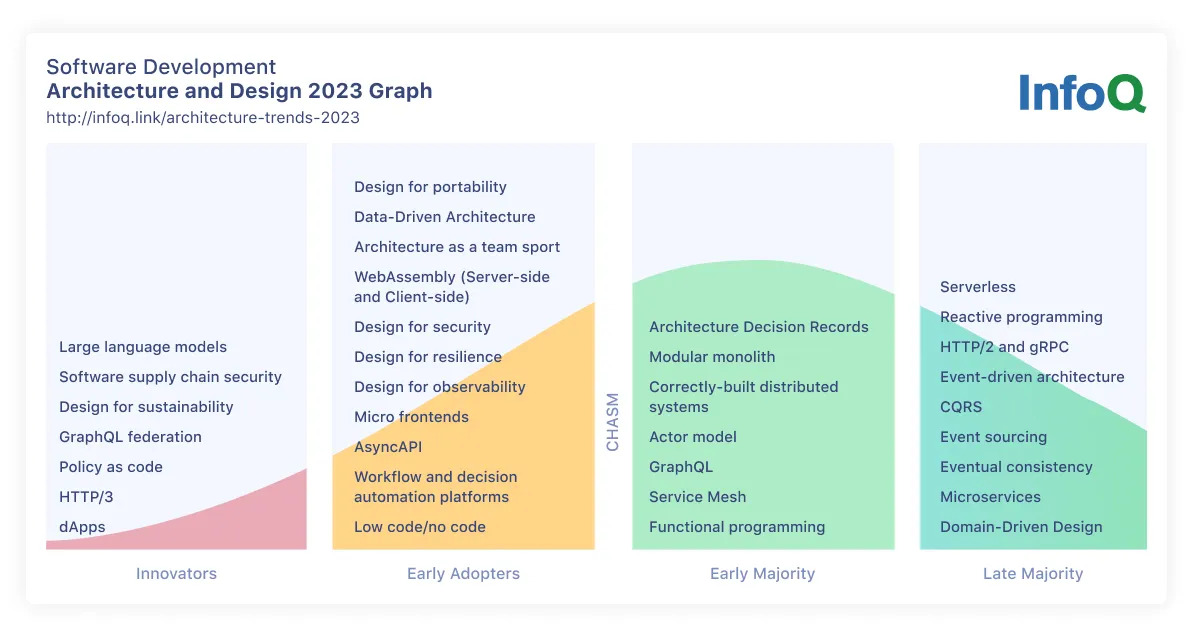Retrospective: Software Architecture and Design Trends in 2023

The world of technology, particularly in software architecture and design, is a continuously evolving landscape. As 2023 draws to a close, it’s time to reflect on the significant trends that have shaped the industry this year.
In this article, we’ll explore prevalent software architecture and design trends, as reported by InfoQ. Our emphasis will primarily center on the Innovators and Early Adopters section, given that the Early Majority and Late Majority are generally well-recognized.

Innovators Section
Large Language Models
The emergence of large language models, exemplified by GPT-3, has marked a transformative leap in natural language processing and AI capabilities. These models, equipped with billions of parameters, have found applications across diverse domains. They have revolutionized content generation, language translation, chatbot interactions, and even code generation, enabling more human-like interactions with machines. However, the widespread adoption of these models has sparked crucial discussions around ethical implications, data biases, privacy concerns, and the responsible deployment of AI.
Software Supply Chain Security
Security within the software supply chain has risen in importance due to the increased occurrence of cyberattacks aimed at the software development process. This encompasses the assurance of the integrity and protection of the constituent components and dependencies integral to software applications. Tasks encompassed within this domain include validating the legitimacy of code libraries, actively surveilling for vulnerabilities, and establishing resilient methodologies for continuous integration and continuous delivery (CI/CD). Notable instances of supply chain breaches, such as the SolarWinds incident, underscore the immediate necessity for organizations to bolster their software supply chain security. Such measures are vital in safeguarding their systems and data against malicious entities.
Design for Sustainability
The concept of designing for sustainability holds immense significance across multiple industries aiming to diminish the environmental repercussions of their products and services. This practice involves embracing eco-friendly design principles, adopting manufacturing methods that optimize resource usage, and considering the entire lifespan of products. Corporations are progressively infusing sustainability into their design and production procedures as part of their efforts to tackle climate change and minimize waste generation. Sustainable design entails employing recycled materials, reducing energy usage, and developing products conducive to effortless recycling or repurposing. Ultimately, these initiatives contribute to fostering a business ecosystem that is both environmentally responsible and socially conscious.
GraphQL Federation
GraphQL federation represents an architectural blueprint facilitating the amalgamation of various GraphQL services into a cohesive API. This framework empowers organizations to deconstruct intricate monolithic GraphQL structures into smaller, autonomous services that can be expanded and managed separately. Federation offers an efficient solution for managing extensive and intricate data graphs, simplifying the construction of adaptable and high-performing APIs. Its utility is especially pronounced in organizations employing microservices architectures, allowing them to uphold a unified GraphQL schema while dispersing development responsibilities across different teams.
Policy as Code
Policy as code embodies a methodology centered on delineating and implementing policies and adherence criteria via code, commonly in a declarative structure. This practice finds extensive application in cloud infrastructure and DevOps, enabling the automated reinforcement of policies to ensure system alignment with security, governance, and compliance benchmarks. By translating policies into code, organizations can uniformly implement and scrutinize security protocols, monitor alterations, and mitigate the likelihood of human errors. Tools such as Terraform and Kubernetes Policy as Code frameworks streamline the implementation and administration of policies within intricate and dynamic infrastructure ecosystems.
HTTP/3
HTTP/3 stands as the most recent iteration of the fundamental Hypertext Transfer Protocol (HTTP) that underpins data transmission across the World Wide Web. It brings forth notable advancements in speed, security, and efficiency when compared to its forerunner, HTTP/2. Constructed upon the QUIC transport protocol, HTTP/3 diminishes latency by curtailing connection setup durations and fine-tuning data transmission methods. Notably, it enhances performance for secure connections, resulting in swifter and more responsive websites. As the realm of web technologies continues to progress, the significance of HTTP/3 in enhancing user experiences and bolstering support for contemporary web applications remains pivotal.
dApps
Decentralized applications, commonly known as dApps, represent software applications constructed leveraging blockchain technology. Unlike conventional applications dependent on centralized servers, dApps function across decentralized networks, providing heightened transparency, security, and immunity against censorship. Employing smart contracts—self-executing agreements governed by predetermined rules—these applications streamline transactions and automate operations. dApps have garnered considerable interest for their promising applications across diverse sectors like finance, gaming, and supply chain management. Nonetheless, hurdles such as scalability and user acceptance need resolution for dApps to realize their complete potential and emerge as mainstream solutions within the digital domain.
Early Adopters Section
Design for Portability
Designing for portability stands as a fundamental concept in software and system architecture, accentuating the development of solutions capable of effortlessly operating across various platforms and environments. This principle encompasses diminishing reliance on specific technologies or infrastructure, ensuring harmonious compatibility, and implementing standardized interfaces. By embracing the ethos of designing for portability, entities can attain enhanced flexibility, mitigate vendor entanglements, and streamline the migration of applications and services across diverse cloud providers or deployment environments.
Data-Driven Architecture
A data-centric architecture revolves around optimizing the management and utilization of data as a fundamental element within a system’s design. This methodology prioritizes data as a central focus, emphasizing aspects such as data modeling, storage, and accessibility to bolster decision-making processes, analytics, and the derivation of insights. Typically, data-driven architectures utilize tools like data warehouses, data lakes, and data pipelines to guarantee the availability, accuracy, and usability of data across diverse business operations and applications.
Architecture as a Team Sport
Architecture functioning as a team sport embodies the collaborative essence of architectural design and decision-making processes within organizational frameworks. This viewpoint recognizes that architecture isn’t exclusively the domain of architects but rather encompasses the valuable insights and contributions from diverse stakeholders, such as developers, operations teams, business analysts, and other pertinent parties. Achieving effective architectural decisions necessitates robust collaboration across functions, fostering a collective grasp of objectives and limitations. This collaborative approach ensures coherence and alignment, guaranteeing that the architecture aptly caters to the comprehensive needs of the organization.
WebAssembly (Server-side and Client-side)
WebAssembly (Wasm) stands as a versatile technology enabling code execution at speeds close to native levels in web browsers and other environments. On the client side, it empowers web applications to run high-performance code directly within a browser, ensuring efficient operation across various platforms. Meanwhile, in server-side applications, WebAssembly enhances the performance of serverless functions and microservices, streamlining the deployment of lightweight and transportable server-side code.
Design for Security
Design for security is a crucial component within software and system architecture, focusing on pinpointing and addressing potential security hazards from the initial stages. This approach encompasses integrating security protocols like access controls, encryption, authentication, and threat modeling into the architectural framework to fortify defenses against vulnerabilities and potential threats. By ingraining security measures during the design phase, organizations foster the development of more robust systems, effectively mitigating the likelihood of security breaches and data compromises.
Design for Resilience
Design for resilience focuses on creating systems that can withstand and recover from failures and disruptions gracefully. This architectural strategy integrates redundancy, fault tolerance, and graceful degradation to guarantee that, even amid adverse circumstances, the system maintains operation or restoration with minimal downtime or data loss. Prioritizing resilience in design proves critical in contemporary applications where uninterrupted uptime and availability hold utmost significance.
Design for Observability
Design for Observability underscores the creation of systems that facilitate effortless monitoring and analysis. This practice involves outfitting applications with logging, tracing, and metrics to gain comprehensive insights into their functionality, performance, and condition. By embracing this observability-driven design, organizations can swiftly identify and diagnose issues, resulting in enhanced troubleshooting, accelerated incident response, and bolstered overall system dependability.
Micro Frontends
Micro Frontends, an architectural blueprint, extends the principles of microservices to the frontend layer of web applications. It revolves around fragmenting the front end into smaller, autonomously deployable components, each accountable for specific segments of the user interface. This methodology empowers teams to independently handle frontend components, streamlining the development, testing, and deployment cycles while preserving a unified user experience.
AsyncAPI
Representing an emerging specification, AsyncAPI serves as a framework for outlining, documenting, and defining the interface of asynchronous APIs. Similar to how OpenAPI is utilized for RESTful APIs, AsyncAPI assists developers and organizations in standardizing the portrayal of message-driven systems, like message queues and event-driven architectures. It offers a lucid method to describe the structure and behavior of messages, simplifying the construction, integration, and maintenance of asynchronous systems.
Workflow and Decision Automation Platforms
These platforms comprise software tools or frameworks devised to streamline and automate business processes and decision-making. They empower organizations to model, execute, and oversee intricate workflows, enabling the efficient automation of repetitive tasks and decisions. Deployable across various industries, from finance and healthcare to supply chain management, these platforms optimize operations and enhance decision-making procedures.
Low Code / No Code
Low code and no code represent development methodologies that empower users with diverse technical proficiencies to create software applications with minimal manual coding. While low-code platforms furnish a visual development environment with pre-built components and templates, no-code platforms streamline the process further, often necessitating zero coding. These approaches accelerate application development, democratize software creation, and equip businesses to promptly adapt to evolving demands without requiring extensive programming expertise.
Conclusion
The year 2023 has witnessed significant strides and transformations in the realm of software architecture and design. From the emergence of large language models and AI advancements to the emphasis on sustainability, security, and evolving architectural patterns, the industry has experienced a myriad of influential trends. As we step into the future, these trends will undoubtedly continue to shape the landscape, driving innovation, and transforming the way we approach software architecture and design.
